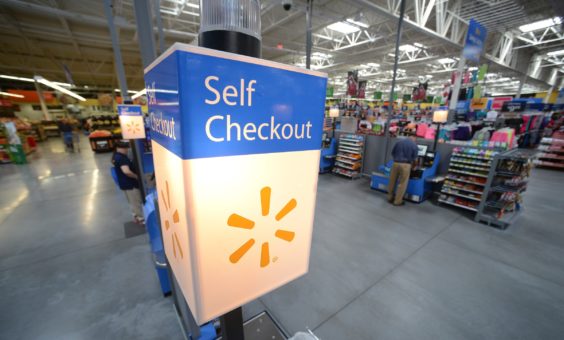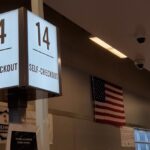
Griping about self-checkout machines has become as cliche as complaining about airline food or snarking about those “Do Not Remove Under Penalty of Law” tags on mattresses. Yet, as though we’ve been transported back to the 1990’s, some people still feel compelled to do it. “Self-checkouts are so annoying! Why would I want to bag my own groceries? Unexpected item in the bagging area! Amirite, folks?!”
Yet it appears that self-checkouts have quietly become more popular than ever.
A new survey of grocery professionals finds that the percentage of shoppers using self-checkout is the highest it’s ever been. Among the many insights in the Food Marketing Institute’s newest annual “The Food Retailing Industry Speaks” report is this little nugget: “Consumer self-checkout usage gained slightly to 15 percent of transactions, which marked a new high for this activity”.
That conclusion supports the findings of an earlier FMI survey of shoppers, in which 25% said the availability of self-checkout is one of the most important attributes in their primary grocery store. That’s up a significant 7% from just two years ago, “a finding that shows growing interest in this feature,” the FMI said.
It is, perhaps, no surprise that tech-savvy, do-it-yourself millennials have a higher-than-average opinion about self-checkout, with 30% of them ranking self-checkout as an important attribute in determining where they shop. What might be surprising, though, is that the generation most likely to approve of self-checkout is seniors, aged 73 and up, with 35% of them naming it as an important attribute in selecting their primary grocery store.
That’s a lot of self-checkout users, considering everyone supposedly hates it.
And it’s not just survey results, but hard numbers that support the premise that self-checkout adoption is growing. The retail research firm RBR recently reported that 2017 “saw another record year for self-checkout deliveries”, with more than 63,000 new units shipped worldwide. That’s up nearly 30% from the previous year, which was already considered a “breakout year”.
“The USA accounts for more than half of shipments, with retailers continuing to invest heavily in self-checkout technology as an integral part of revamping their store layouts,” RBR noted. “Big box players such as Walmart and Kroger have added extra terminals in existing stores and upgraded older hardware.”
The previous year’s RBR study credited the surge in self-checkout shipments to the fact that “big-box chains such as Target have revamped their checkout zones, increasing the number of self-service lanes per store and installing terminals in outlets which did not previously have the technology.”
Target was a longtime self-checkout holdout, until it gave in and began installing them across the country in 2014. They’re now in a majority of Target stores, with all stores expected to have them by next year. “We’ve heard great feedback from guests who love having checkout options,” Target says, while noting that about a third of Target shoppers are self-checkout users.
And despite the concerns from some that self-checkouts are part of a plot to cut down on labor costs by employing fewer cashiers, Target says it’s actually hiring more employees. The conventional wisdom cited by many self-checkout-offering retailers is that requiring fewer cashiers frees up employees to do other tasks, like assisting customers or keeping shelves stocked.
Part of the reason more retailers and shoppers are embracing self-checkouts now more than ever, is that the checkout software has improved dramatically. Despite the apocryphal complaints that it happens all the time, when was the last time you actually heard “Unexpected item in the bagging area?”
“Self-checkout technology has improved immensely over the years, and is now more sophisticated than ever,” NCR explained in marking its 20th anniversary as a self-checkout manufacturer earlier this year. “Using advancements such as computer vision to reduce false alarms and other shopper interruptions, we are continuously driving toward a frictionless in-store experience.”
Among those advancements are image scanners that can recognize items placed on the self-checkout scanner. This can help speed the process, makes scanning fruits and vegetables easier, and also prevents thieves from swapping bar codes or putting an expensive item on the scanner and entering a code to weigh it as though it’s a bunch of bananas.
While some retailers have very publicly pulled self-checkouts out of their stores in recent years, claiming that customers don’t like them and that they prefer interacting with human cashiers, others that have done so have quietly begun bringing them back. Improvements in the technology and changing shopper attitudes have made it more difficult to resist self-checkouts’ perceived benefits.
Despite the improvements, though, one of the sticking points in the increased adoption of self-checkouts is what to do about coupons. Retailers like Walmart, for example, let you scan your own paper coupons and drop them into a slot. So Walmart self-checkouts have become the checkouts of choice for coupon fraudsters, who find it easier to use high-value coupons on items for which they’re not intended, or even counterfeit coupons, when there’s not a human cashier there to scrutinize them. Retailers like Target let you scan your own coupons, but an attendant has to come verify them before approving your transaction. And still other retailers force you to hand over all of your coupons to an attendant to scan for you, which can slow things down and defeat the whole do-it-yourself purpose of going to a self-checkout in the first place.
Some, though, see a future where there are no paper coupons or physical self-checkout stations at all. Several retailers have been experimenting with scan-as-you-go technology that allows you to use a handheld device or your own phone to scan items as you shop and pay at the touch of a button, so you don’t have to pull everything out of your cart when you’re ready to leave. And “Amazon Go” stores use cameras to watch what you grab off the shelves, and your account is charged automatically.
So if you still like having face-to-face interaction with a human cashier, it’s still possible. But if you prefer to go it alone – it looks like you’re going to have more and more opportunities to do just that.
Image source: Walmart










